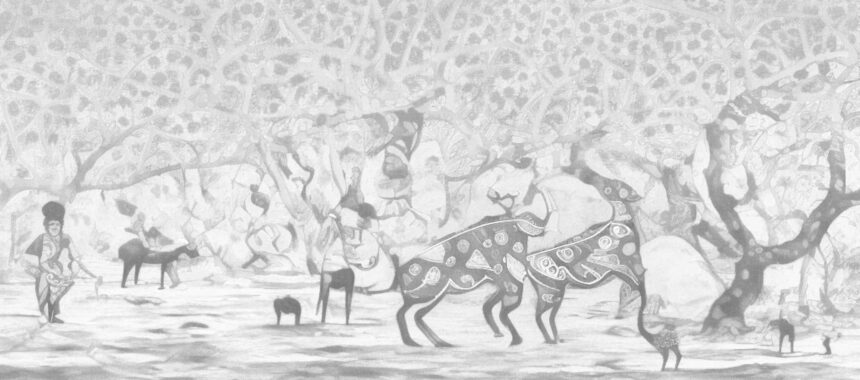Gond paintings are vibrant paintings created with a series of intricately arranged dots and dashes. Developed by the Gondi tribe of central India, Gond paintings are the truest form of tribal art that take us on a beautiful journey of mythological tales, historical events and important rituals, and traditional songs presented through visual art. People would use this non-canonical art to decorate their houses to ward off evil and bring in good luck and prosperity. Even though the Gondi tribals used humble ingredients like cow dung, plant sap, charcoal, colored soil, flowers and leaves, the colors they produced were bright and rich, and were used to fill in intricately depicted scenes.
With a population of 4.4 million, Gond is the second largest tribal community in Central India, whose origin can be traced back to the pre-Aryan era. While the Gond people are believed to have been around in India for nearly one and a half millennia and have been creating this art form for that entire duration, historians suggest that the art form itself may be much older and the Gonds could be improvising on cave paintings dating as far back as the Mesolithic era.
The word Gond has its origin in Dravidian language, and means kond, or the green mountain. Though believed to be exclusive to Madhya Pradesh, the tribal Gond art is also practiced in Maharashtra, Odisha, Chattisgarh and Andhra Pradesh (states spanning central and eastern India).
Art that worships nature
The Gonds hold sacred all naturally occurring objects like trees, rivers, rocks, mountains etc. because they believe these are inhabited by a divine entity. Their paintings reflect this reverence and respect for nature and its elements, and shows how man and nature must co-exist. Gond artists also like to paint about traditional Indian mythology, folklore, scenes from daily life and abstract ideas such as dreams and imagination.
While Gond art is inherently tribal, don’t mistake it for rough sketches or childlike drawings. Gond artists are known for their attention to detail such as drawing inner and outer lines to achieve a high level of perfection, and using fish scales, dashes and dots creatively to lend a sense of motion to the painting. Gond artists like using vivid colors such as yellow, red and blue on and white. Dyes are obtained from plant sap, animal manure, colored soil, leaves, locally available sand and charcoal. They use a technique of creating an almost three-dimensional effect in their paintings. The artist starts with an outline, which is then filled with block colors. Once dry, elaborate patterning is painted on top that looks like the art is popping out of the base. The technique is precise and the elaborate patterns take a lot of time to create.
The art has evolved over the years, and by the 1980s Gond artists transformed this ancient style with a new narrative and figurative ideas, adding humor, mystery and stories that made each painting come alive. They also began using modern material such as ink, acrylics, animated film and silkscreen prints.
The meaning behind the symbols
The Gond tribe believed that seeing a good image, or a drawing, brought good luck. That’s why they would decorate the walls and floors of their houses with traditional motifs that revered natural spirits. Apart from painting the local flora and fauna and Goddess such as Marahi Devi and Goddess Kali, Gonds also paint the objects of daily life. The predominant theme is veneration of nature and the symbiotic relationship between birds, beasts and trees, but they also paint depictions of various celebrations and Indian festivals.
Gond art today
Gond art is rooted in their folk tales and culture, and so story-telling is a strong element of every painting. Over the years developed every artist has a personal style and a specific language within these narratives creating a richness of different styles. The first Gond artist to gain recognition was Jangarh Singh Shyam who was the first artist to paint on paper and canvas. He hosted a very successful first exhibition in Bharat Bhavan in 1981, and his meteoric rise to fame was underlined by subsequent exhibitions in Paris and Tokyo.
In 2000s, Gond art entered a new era of storytelling though animation and films, as well as new media like wooden trays and boxes. Gond artists have traveled abroad for exhibitions and Pradhan Gond paintings have gained popularity in the mainstream art market, supported by the Indian government who is taking great pains to preserve Gond art.
About the author: Sushmita Vobbilisetty is the concept creator at Chitrapata. She has a deep understanding of old masters, modern, and contemporary artworks. Sushmita is an expert in evaluating the market value and fair value of art based on heritage, availability, sell-through rate, market performance over time, secondary sales track record, and other key factors. Sushmita frequently predicts the bidding prices for day sales and evening auctions hosted by leading art houses.
About us: Chitrapata is a digital atelier with an in-house generative art technology platform enhanced with machine learning and artificial intelligence capabilities. Our vision is to spark thoughts, conversations, and debates among different groups. Visit “About us” section to know more about our philosophy, vision, bio, artist statement, story and technology process.
Image credit: DreamStudio AI, StableDiffusion.

